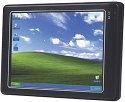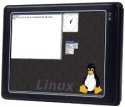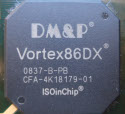Panel PC uses “two Watt” x86 SoC
Jun 19, 2009 — by LinuxDevices Staff — from the LinuxDevices Archive — 5 views Icop announced a panel PC that runs Linux on the company's own 32-bit, x86-compatible SoC (system on chip). The PDX-089T has a 8.9-inch touchscreen display, 256MB of RAM, CompactFlash Type I/II and microSD storage, plus a Mini PCI slot, the company says.
Icop announced a panel PC that runs Linux on the company's own 32-bit, x86-compatible SoC (system on chip). The PDX-089T has a 8.9-inch touchscreen display, 256MB of RAM, CompactFlash Type I/II and microSD storage, plus a Mini PCI slot, the company says.
(Click here for a larger view of Icop's PDX-089T)
 Icop's earlier PDX-057T (Click image for further information) |
The PDX-089T is said to employ Icop parent company DMP's Vortex86DX, announced in November of last year and previously used in a 5.7-inch panel PC, the PDX-057T shown at right. Compared to the PDX-057T, which was released in February, the PDX-089T ups screen size to 8.9 inches, and it also increases screen resolution from 640 x 480 to a netbook-like 1024 x 600 pixels.
Again, the device features a resistive touchscreen display, 256MB of RAM, and CompactFlash Type I/II and microSD expansion slots, both externally accessible. The Vortex86DX processor is clocked at 1GHz, and, though regrettably shown running Windows XP in the picture at the top of our story, is also claimed capable of running Linux, Windows CE, and DOS.
The PDX-089T, which weighs just over a pound, includes two USB ports, “optional” audio output, an RS232/422/485 serial port, a 10/100 Ethernet port, and a PS/2 port for keyboard/mouse connection. The panel PC also sports a connector for an optional antenna, relevant when a wireless LAN card is installed into the device's Mini PCI slot.
One model of the panel PC, known as the PDX-089T-5A, accepts 5VDC input power from an external 15W adapter. An alternative version, the PDX-089T-8A, replaces the barrel connector with two terminals, said to be capable of accepting input voltages varying from 8VDC to 15VDC. This model likely targets use in vehicles. Holes on the rear of the device, meanwhile, conform to the 75 x 75mm VESA mounting standard, Icop says.
Features and specifications listed by Icop for the PDX-089T include the following:
- Processor — 1GHz Vortex86DX
- Memory — 256MB of DDR2 RAM
- Display — 8.9-inch resistive touchscreen display with 1024 x 600 resolution and 500:1 contrast ratio
- Storage — Includes CompactFlash Type I/II and microSD slots
- Networking — 10/100 Ethernet
- Other I/O:
- 2 x USB 2.0
- 1 x RS232/422/485
- 1 x PS/2
- Audio line out (optional)
- 2 x USB 2.0
- Expansion — Mini PCI slot
- Operating temperature — 0 to 60 deg. C (32 to 140 deg. F)
- Power requirements — 5VDC (PDX-089T-5A) or 8VDC to 35VDC (PDX-089T-8A)
- Dimensions — 9.31 x 5.75 x 1.38 inches (236.6 x 146 x 35mm)
- Weight — 1.03 pounds (468g)
Background
 The Vortex86DX (right), announced in November of last year, is built using a 90nm process, comes in a 27 x 27mm package, and is said to use under two Watts while running at up to 1GHz. The Vortex86DX includes the complete 486SX instruction set, adding floating point support, says DMP.
The Vortex86DX (right), announced in November of last year, is built using a 90nm process, comes in a 27 x 27mm package, and is said to use under two Watts while running at up to 1GHz. The Vortex86DX includes the complete 486SX instruction set, adding floating point support, says DMP.
Unlike DMP's previous Vortex86SX, the SoC is capable of running Windows XP and Windows XP Embedded, in addition to the already supported Linux and Windows CE, has 256MB of embedded L2 cache, and supports up to 1GB of 33MHz DDR2 memory, according to DMP. (For more details on the Vortex86DX, see our earlier coverage, here.)
 Icop's VDX-6354 module also uses DMP's Vortex86DX (Click for details) |
The Vortex86DX SoC doesn't include an IGP (integrated graphics processor), though DMP added VGA to its subsequently released Vortex86MX. We suspect that Icop has given the PDX-089T VGA capabilities using a separate XGI Volari Z9s chipset, just as it has already done on previous products such as the VDX-6354 PC/104 module (right).
Further information
According to Icop, the PDX-089T runs Linux, Windows CE, Windows XP, and DOS. Pricing was not released, but the device will be available during the fourth quarter of this year, according to U.K. distributor Datasound Laboratories. More information on the PDX-089T may be found on the Datasound website, here.
This article was originally published on LinuxDevices.com and has been donated to the open source community by QuinStreet Inc. Please visit LinuxToday.com for up-to-date news and articles about Linux and open source.